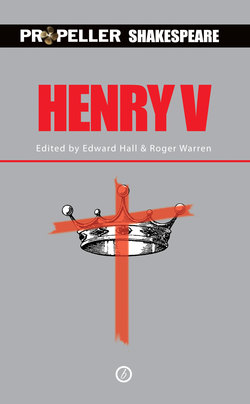Читать книгу Henry V (Propeller Shakespeare) - Уильям Шекспир - Страница 10
На сайте Литреса книга снята с продажи.
The Process of the Music for Henry V
ОглавлениеThere are many different types of musical styles in our production of Henry V. What unites them all is the earthy root of thirteen male actors performing it together to create an effect: to communicate something to the audience at a particular time. A Chorus both theatrical and musical. Whether creating an ecclesiastical atmosphere for the first scene between the Archbishop of Canterbury and the Bishop of Ely, or the lager-fuelled party of Pistol, Nym and Mistress Quickly, the power of having thirteen blokes all singing and moving together is a great storytelling force.
The trick is to harness what we have. We sat around on Day One and established whether anybody could play anything, and then Edward Hall said we needed a Te Deum and Non Nobis. Having played and written for piano and guitar in various shows, I said I’d give it a go. Others pitched in with what they could do. So we ended up in differing parts of the show with tap dance, accordion, saxophone and guitar all pootling away alongside four-part harmony choral singing.
We began to learn songs as a group — all of us standing around the piano, and taking various folk songs that we knew and playing with them — seeing whose voice sat where, who could accompany etc. Out of this came the folk tune ‘John O’Dreams’, that we now sing to introduce the Chorus of ‘Now entertain conjecture of a time’… on the night before Agincourt. We just sang it together for ages — a soft, beautiful tune which we split into four harmonies, listening to each other together filling the room with simple sound.
By the time I came to write the Te Deum and Non Nobis it was easy. I dreamt up an introduction and theme for it, but I never wrote it down as a piece of music. We just picked it out and fashioned it together into a rousing, spiritual piece with a religious, ‘choric’ feel. Gunnar Cauthery then said he would write a Requiem in response to the Te Deum — so in the two big Choral numbers there is a deliberate musical correlation. We then used his same music for the Kyrie. Once we had a musical language we found we could knit all sorts of things together. We created contemporary soldiers’ songs which allude to contemporary music.
Actors are extraordinarily adaptable creatures and will learn things very quickly, but to me, there is no point in imposing a piece of music or dance upon a group when most of them are intimidated and don’t think they can do it. They won’t enjoy what they’re doing, it is alien to them, and they won’t sing it very well. If it comes from the group, and we find it together, then the whole group can invest in it, find our joy in it, and therefore communicate what we need to do all the better. To me, there is no difference between dividing up the lines of the Chorus speeches, and the division of the music amongst the company. Each man plays his part. To say I wrote the Te Deum, or did the arrangements for some of the songs, is true in one sense, but actually it came from us all. And I still haven’t written it down.
Nick Asbury
